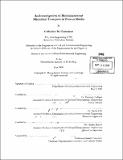An investigation of bioluminescent microbial transport in porus media
Author(s)
Castenson, Catharine M. (Catharine Marie), 1976-
DownloadFull printable version (12.70Mb)
Other Contributors
Massachusetts Institute of Technology. Dept. of Civil and Environmental Engineering.
Advisor
Patricia J. Culligan, Martin Polz and Charles Harvey.
Terms of use
Metadata
Show full item recordAbstract
Since bacteria play a significant role in the composition of the subsurface, understanding the transport of microorganisms through groundwater and porous media is of great importance. Recently, increased study of microbial transport in the subsurface has been driven by the development of in-situ remediation techniques utilizing bacteria's natural ability to degrade contaminants in the subsurface. To date, research in microbial transport within soil and groundwater has been conducted extensively without any physical visualization of what is occurring in the subsurface. Because the factors that control the transport of bacteria through soil and groundwater are not well understood, direct visualization of microbial transport in the subsurface would be extremely valuable in understanding soil, microbial, and groundwater interactions. This project sought to investigate and develop a means of visualizing microbial transport through porous media. A system incorporating bioluminescent bacteria, as a visual indicator of both microbial transport and activity, was coupled with a transparent porous medium that allowed the bioluminescent bacteria to be directly visualized as they were transported through a model aquifer system. The investigation of microbial transport was performed at a range of pore fluid velocities, varying from 1.31E-5 m/s to 2.21E-4 m/s. Results acquired from the experimental setup were reproducible at similar flow rates and bacterial cell concentrations. The two main factors controlling microbial transport and activity were found to be flow velocity and oxygen concentration levels. The degradation and consumption of oxygen and contaminants is related to the amount of time microorganisms spend in particular pore spaces. Faster flow rates allow the bacteria to move through the soil without consuming all of the available oxygen, but may not allow the bacteria enough time to degrade the contaminant. Alternately, bacteria traveling through soil at slower flow rates consume all available oxygen before traveling too far. For the flow rates tested with this research, microbial flow was found to follow the flow pattern of a color tracer. However, at the lower flow rates, an oxygen depletion zone developed behind the advancing flow front. The width of this zone was observed to increase with time, resulting in a reduction of bioluminescent activity, and thus, degradation activity, within the system.
Description
Thesis (S.M.)--Massachusetts Institute of Technology, Dept. of Civil and Environmental Engineering, 2000. Includes bibliographical references (leaves 101-106).
Date issued
2000Department
Massachusetts Institute of Technology. Department of Civil and Environmental EngineeringPublisher
Massachusetts Institute of Technology
Keywords
Civil and Environmental Engineering.